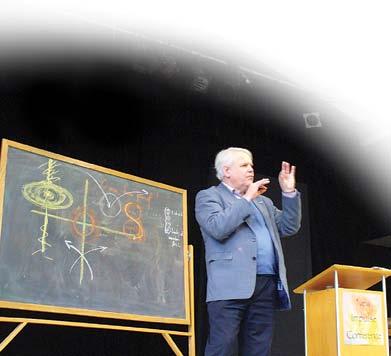
6 minute read
Waldorf: “A New Impulse” Conference
February 18-20, 2010, San Rafael, CA
Rudolf Steiner
With these words spoken at the faculty meeting of the Stuttgart Waldorf School, July 24, 1924, Rudolf Steiner ends his engagement in the original Waldorf School. Ninety years later we might ask ourselves: Do we now also need a new impulse? How can we balance structure and form with impulse and creativity so that they serve a “new impulse” for Waldorf schools—an impulse that is needed as we approach the centenary of this new educational paradigm?
These thoughts formed the “seed crystal” around which the Bay Area Center for Waldorf Teacher Training imagined and structured the conference. More than 200 Waldorf professionals from six states representing more than 30 schools attended.
Using references to contemporary research and autobiography, Schiller’s Letters on the Aesthetic Education of Man, lively anecdotes, personal research, humor, straight talk, and insightful comparisons of familiar Waldorf verses and meditations, Christof Wiechert brought us an utterly fresh and refreshing way of seeing the human being, the world, our tasks as Waldorf educators and ourselves. Head of the Pedagogical Section in Dornach and main speaker at “A New Impulse,” Christof splendidly modeled the content of his lectures.
He reminded us that our task as educators is to ensure that the teacher and the pupils/students always form a unity. This unity develops out of our deep interest in our fellow human beings and out of enthusiasm born of love for everything that is in the world around us (love every subject you teach).
Christof said one way to find unity with our pupils and students is in realizing that, perhaps surprisingly, we are not here to educate the individualities before us. Individualities, the spiritual essences of human beings, come into physical existence to educate themselves. We teachers are here to educate the sheaths that are receiving those individualities. That is, Waldorf education addresses the physical body, the senses, purposeful movement, soul, heart, imagination, thinking, all with clarity and rigor—but not the unique individuality itself.
We learned that different capacities for judgment develop in different seven-year periods: aesthetic, with the physical body (1-7); intellectual, with development of the soul (7-14); idealistic, with the longing for identity and authenticity (14-21); personal when the full individuality is present (from 21 on).
Christof reminded us of what Rudolf Steiner said at the beginning of Study of Man: Unity that is born of interest (in each human being) and enthusiasm (for the whole world) begets a new moral relationship, for our task as Waldorf educators is not only intellectual and emotional, but also moral and spiritual. In order to educate in a way that respects the sanctity of the child’s individuality, we have to develop moral techniques:
• Take each child/student as s/he is; do not label.
• With this as the starting point, find an individual way to work with each child. Note: There is no longer such a being as an “ideal child.” This may have existed fifty years ago, but conditions have now changed.
• Wholeheartedly accept the child/student as s/he is.
• If the child/student is not “performing” as you would like (in meeting standards, in behavior), look within yourself, not at the child or student for the answer to the riddle of why. Note: No child or student wants to perform badly, and every single one wants to learn.
Christof showed us ways to better understand the situation of the modern child or youth. The physical body has two basic urges: the urge toward matter (physical necessities and all that we find in the physical world) and the striving toward organized life, form and structure. Out of this duality there develops a third realm: the urge to play. It is only in play (in the wider sense of the word) that we can find freedom. This is also the realm of imagination and initiative.
We can also look at the polarity between sensory ‘input’ and personal, active ‘output’. When we do not find individualized soul life developing between these two poles, we see that ‘input’ with no ‘output’ is what characterizes autism. ‘Input’ with unprocessed, immediate ‘output’ is what we find in hyperactivity.
Even more arresting is the realization that between ‘input’ and ‘output’ is the middle realm, the realm of images, stories, metaphors, and play. This is where there is human experience. It is just this human experience of perceiving, thinking and speaking that the spiritual beings we work with are looking for. Thus, our educational task takes us into a new paradigm, one that reaches across the threshold, beyond the intellectual and emotional to the moral and spiritual.

Christof Wiechert
In 2019 we come to the 100th anniversary of Waldorf education. Christof suggested that we have some work to do before we can celebrate with all the enthusiasm such an event should engender in us. He mentioned the following focus points:
• Re-balance the material/organizational/structural and play/ imaginative /initiative forces in our schools.
• Eradicate from our schools habits unrelated to Study of Man.
For example: too many stories; Form Drawing in blocks; “Circle Time” (see his research soon to be published in the Pedagogical Section Journal); starting the day with movement because children no longer walk to school.
He left us with several blackboard images of familiar verses and meditations to ponder in our hearts and enliven our inner work. He reminded us that the Second Teacher’s Meditation (“Geistiges blicken…”/“Spirit beholding…”) was given to the first Waldorf teachers after a crisis and was meant as an “energy boost.”
Indeed, participants felt that “A New Impulse” conference itself served as an energy boost, and the decision was made to have Christof return next February for “A New Impulse II.” We look forward to the opportunity to continue and deepen our work together.










